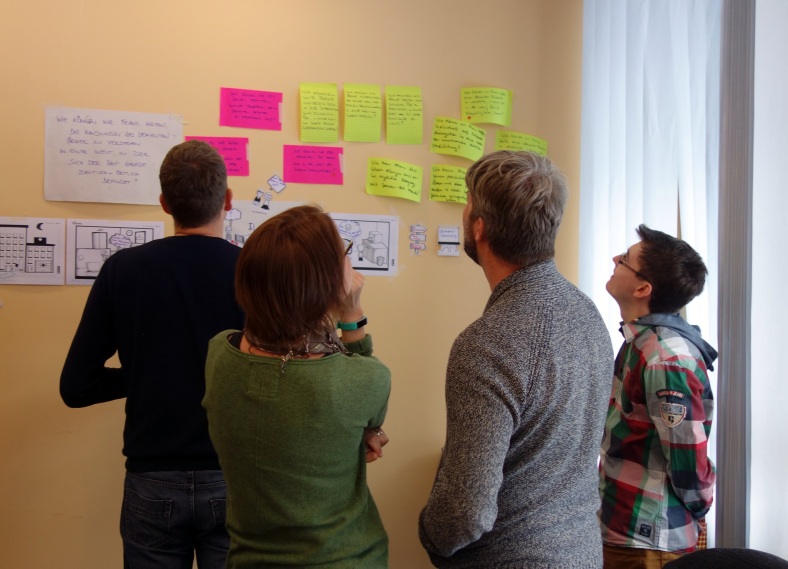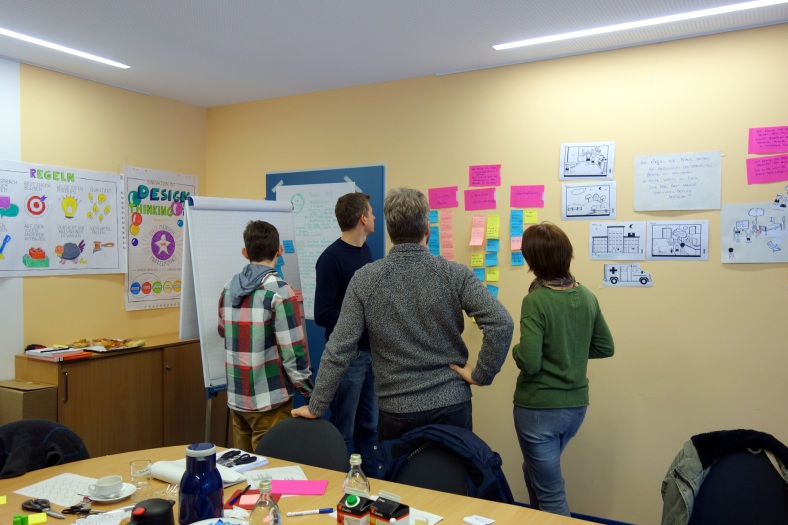My role as project leader for innovations was to help the nursing department and school by providing a novel approach to project management using Design Thinking methods. The aim was to develop to a design-led organization.
Previously, the team leaders of the nursing staff have learned new leadership methods, like ‘New Work’ in external consultancy workshops. New Work is the collective term for forward-looking and meaningful work. The course explained and answered the question how work is defined and organized innovatively in order to make a growing contribution to corporate strategy. New Work is neither a program nor a process, but a matter of attitude, culture and leadership. It is characterized by appreciation, which involves more coaching and less announcements. The employees are the highest asset and must be at the center of our actions in times of talent scarcity.
My role involved the implementation of new project management methods and work approaches. In doing so, I used the Design Thinking framework to include the end user in the innovation process from the beginning. Additionally, it was possible to visualize complex projects for all stakeholders in multi-day workshops and in individual meetings.
With four hospital wards, new ideas were worked out in three two-hour workshops each in order to improve the structure of each ward.
In this three-day workshop, two healthcare companies worked together to create better collaborative processes.
Teaching the students about Design Thinking using the one hour school bag challenge
In this four-day workshop, two prototypes on the subject of employee recruitment were developed and tested.
This way of working is very novel in the German health care system and there are not many possibilities for comparison across the industry. However, participants were always stunned how quick the development of new and innovative solutions was followed by a structured and visually shaped outcome. The end user was involved from an early stage throughout all processes. Usually, making such a change in a large and traditional company takes a lot of time. However, RoMed has made it their mission to improve the environment for both patients and employees.

Design Thinking can help solve complicated problems creatively and visually. Productive workshop with the teachers on the topic of new legal changes.

Design Thinking introduction to the nursing directors using the ‘Gift giving challange’. This showed them how to achieve innovation with a Human Center approach.
RoMed tries novel approaches with Design Thinking
The RoMed clinics performed their first Design Thinking Sprint as part of the new legislation for carer and nurses. This was done in interdisciplinary teams, which achieved novel solutions for their current challenges.
A five-day workshop was planned and performed by me at the site in Wasserburg in January 2019. The responsible nursing manager and team member, Mr. Brunnlechner, was encouraging the new format. The aim of this sprint was to find a solution, which would improve the communication and team spirit within care teams and relatives of dementia patients.
How can employees and relatives of people with dementia be supported?
What exactly is Design Thinking? Although this method was originally developed by designers, the word “design” in Design Thinking does not only mean the development of something tangible, but also emphasizes the importance of the creative thinking process. It is therefore a human-centered approach in which a problem is first identified and then a suitable solution developed. Design Thinking is a solution-oriented process which involves both end customer and employees. This is the strength of this method, because it uses many years of experience. The employees know the daily routine and thus can prioritize the solutions according to impact. This is the a way to evolve from a problem to a solution-oriented business, where employees are given the opportunity to actively shape their workday.

Figure 1: Structure of Design Thinking, developed at the Hasso Plattner Institute.
The benefit of a design sprint is the rapid development of new ideas and their immediate testing. There are several frameworks that could explain this process, but they all share an iterative process. This allows an improvement between the individual phases until the appropriate solution is found.
First, a team selection was made for the sprint at the RoMed clinics. Here, it was important to find a diverse mix of employees and students. Some team members had experienced dementia care training with different age structures. The interdisciplinary team allowed a variety of views and opinions about the subject. I opted for a structure, developed by the renowned Hasso Plattner Institute at the “D.School” (Fig. 1). This consists of 6 Iterative building blocks:
- Understanding
- Observing,
- Defining views
- Finding ideas
- Developing and
- Testing prototypes.
From problem to prototype, the fast running of a sprint
In the second step, the team prepared for the interview. It developed questions to gain a better understanding of the daily issues that arise between employees, relatives and patients. For the formulation of the questions, it was especially important to have an open conversation with the interview partner. This way, real empathy could be developed to understand the problems and worries. Over 120 core statements on dementia were collected, bundled and sorted into subject areas in the interviews for the fields of “Nursing Management”, “Nursing and Nursing” and “Concerned”.
The third step was all about creating suitable personas to bundle the needs and to keep them present for the further course of the project. A persona is a fictitious person representing the end customer. Here, the team split into two groups on the topics of “biography work” and “knowledge transfer”. The outcome was visualized in a Journey Map to show gaps and problems (Figure 2). Personas and Journey Maps are great ways to showcase people and their needs, helping to keep track of the real issue throughout the process.

Figure 2: Creation of a “Journey Map” to visualize the problem area
After the problem visualization, it was time for the “how might we …” or “how can we …” questions that specifically address the persona and your needs (Figure 3). Two key questions have been agreed after a thorough selection process:
- How can we gain more knowledge about dementia in order to adapt the need for the dementia patient in the hospital?
- How can we help caregivers to get more information, in an environment that is subordinate to the individual patient’s needs?

Figure 3: Collection and selection of “How can we …” questions
All groups went into the ideation with these questions in mind. They created over 100 ideas, which were collected and sorted using various methods, such as the “hot potato” (Fig. 4). At the end, two final ideas could be identified:
- Team 1 developed a biography sheet for dementia patients and relatives in individual care
- Team 2 the framework conditions for the introduction of a dementia expert


Figure 4: Collection and discussion of new ideas
Strengths, weaknesses, opportunities and threads of the ideas were evaluated with the S.W.O.T. Method. This created new perspectives and improved the following prototypes.
I facilitated the leap to prototyping with small actions that promoted creativity through the artistic creation of various words such as “confidence,” “courage,” and “sympathy” (Figure 5). This helped the teams in the next step to develop the elaborated prototypes, which were immediately tested afterwards.

Figure 5: Exercises to promote creativity
The advantage of Design Thinking is the immediate reception of feedback on the developed prototypes. As a result, errors can be remedied early or an entire idea can be rethought and rejected. In our case, both teams went into separate test phases.
Team 1 performed a role-playing game to simulate the reactions of the test subjects. This method proved to be very efficient, as the role could be given a targeted feedback. The test persons felt present in the simulated situation and were thus able to behave realistically. It revealed potential errors in the questionnaire.
Team 2 opted for a visual presentation using the Journey Map, which provided the requirements and roles of dementia experts. Both teams received constructive feedback from the test subjects. The results were included in the final presentation for senior management (Fig. 6). Both projects are now prepared for implementation in daily operation.

Figure 6: Production of the final prototype
Trusting the process is not always easy
“Trust the process” was my mantra, to which the participants were very skeptical at the beginning. Mr. Brunnlechner was astonished by the fast process: “It was a mystery how we would get from the ideation with more than 100 ideas to a testable prototype within 1.5 days. But the process and the use of various methods by Mrs Merget led us to our destination pretty quickly.”

























